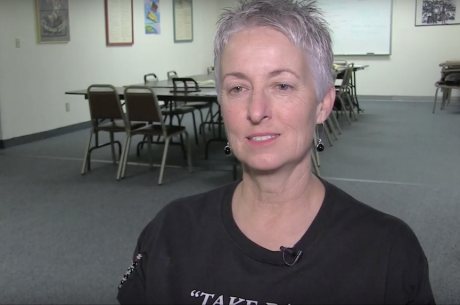 For Deborah Romero, a first grade teacher in Las Cruces, N.M., the first week of school is one of the most important weeks of the year. It’s when connections are made between students and their teacher, routines are established and expectations set, and the anxiety of a new school year turns to excitement. But last year, Romero missed the first week of school.
For Deborah Romero, a first grade teacher in Las Cruces, N.M., the first week of school is one of the most important weeks of the year. It’s when connections are made between students and their teacher, routines are established and expectations set, and the anxiety of a new school year turns to excitement. But last year, Romero missed the first week of school.
She went to court, instead, to take a stand against New Mexico's teacher evaluation system, which uses value added modeling (VAM), a formula that has proven to lead to unfair and inaccurate performance evaluations.
Across the country, more and more educators are headed to court to quash test-based evaluations that have been shown to be unfair and often riddled with errors, offer little guidance, and put educators at risk of being punished or fired, which are the same issues playing out in New Mexico.
“You don’t miss the first week of first grade unless you’re on your death bed, but I did it because I believe in what I was doing,” says Romero, a teacher at Cesar Chavez Elementary School. “Down the road this is going to help teachers and my students.”
Romero is part of a lawsuit, filed by NEA-New Mexico (NM), to overturn the evaluation system, which strips local control from school districts. The Association argues that the state constitution gives local districts the power to set parameters for teacher evaluations, not the state, which has already overstepped its boundaries.
In an interview with The Grand County Beat, Betty Patterson, president of NEA-NM said, “As a union of education professionals, we are deeply committed to the success of every student. We hope to undo the great harm being done to New Mexico students by this evaluation system. It overtests students and is causing excellent teachers to leave the profession.”
‘Would You Rather Have a Hand or a Foot?’
VAM was first used in New Mexico for the 2013-2014 school year. At the time, the secretary of education for the state’s Public Education Department (PED) directed local district superintendents to choose from several criteria to make up a portion of the evaluation.
The Las Cruces superintendent had offered the following options: either attendance can count against teacher evaluations or student surveys.
To Romero, this was equivalent to asking, “Would you rather have a hand or a foot?”
 Deborah Romero, first-grade teacher in Las Cruces, N.M. and a plaintiff in NEA-NM's lawsuit against the state's evaluation system.
Deborah Romero, first-grade teacher in Las Cruces, N.M. and a plaintiff in NEA-NM's lawsuit against the state's evaluation system.
Neither option was good, she says, but most chose attendance. “It was the one thing we could control to a certain measure,” as no one knew what the student survey contained, how it was going to be administered, and how much would count toward the evaluation.
Student test scores already made up 50 percent of an evaluation. Attendance accounted for an extra 10 percent, if educators used all 10 days of their sick time—but even if one day was used, it still counted against them and had the potential to change their rating from “effective” to “ineffective.”
The way sick days were calculated into the evaluation also added to educator frustration. For example, if five sick days were used last school year, and all 10 days the current year, the district marked it as 15 days of absences.
After 18 years of teaching, Romero was labeled minimally effective last year, despite being nominated three times throughout her career as teacher of the year and was a runner-up one of those years.
“I used my sick time and I had several children opt out of the test,” she explains. Las Cruces is one of a growing number of cities where parents have opted out their children from taking the standardized tests, like PARCC. If less than 95 percent of a class take the test, a teacher’s evaluation suffers.
Romero also contends with the rigorous demands required by administrators. Lesson plans, for example, must be placed near the door of her classroom each week and include detailed accounts of her teaching methods.
“It starts to shake your core,” Romero laments. “If I know little Johnny has speech impediment and he needs to be looking at my lips when I’m talking because he needs to see how my tongue and teeth are forming letters and sounds…why in the heck do I have to write all that down in my lesson plan every week?”
Organizing Matters
Aside from the lawsuit, teachers are organizing. Take Sylvia Garcia, a 27-year veteran teacher. If there’s a rally, board meeting, or forum to attend, she’s there, advocating for her profession and students.
Last year, she was a part of an organizing effort that brought more than 500 people to Las Cruces. “It was one of the biggest rallies we ever had,” says Garcia, “and our message was clear: we need to focus on students.”
Additionally, nearly 500 teachers signed a grievance filed by NEA-Las Cruces that demands the district provide specific information on how they’re being evaluated. There’s been plenty of one-to-one conversations, too, where teachers are encouraging other educators to have districts suspend all harmful actions and consequences caused by VAM.
Organizing efforts also led to a change in the Las Cruces school board. Last year, two seats on the board of education were up for grabs in the general election. Becky King, a retired teacher of nearly 40 years, held a “meet and greet” at her home with the two candidates NEA-Las Cruces supported, attended events, and was among the many who knocked on more than 2,000 doors.
For change to happen you must be a part of the process, says King. “You can’t be passive. Otherwise, you don’t accomplish things.”
“When I went door to door, I found that most people knew a teacher or was married to one. They knew what was going on in the classroom,” such as educators not wanting to take leave to care for a sick child or an elderly parent.
“This was about getting out there and doing something,” King says. “Had we not gone door to door, it probably would have been status quo.”
Lawsuit Status
The NEA-NM lawsuit is expected to be heard this fall, along with another suit filed by the American Federation of Teachers New Mexico, which argues that VAM is unfair and puts educators at risk of being punished or fired.
With pressure from both unions, the department of education has already removed a measure that tied teachers to data from students they never taught, as well as data that was more than a year old.
And while educators wait for the court’s ruling, they remain active and hopeful. “The system seems to be crumbling,” says Romero who wants a more humane system in place. “It’s not that we don’t want to be evaluated, but we want something that’s appropriate and meaningful.”








